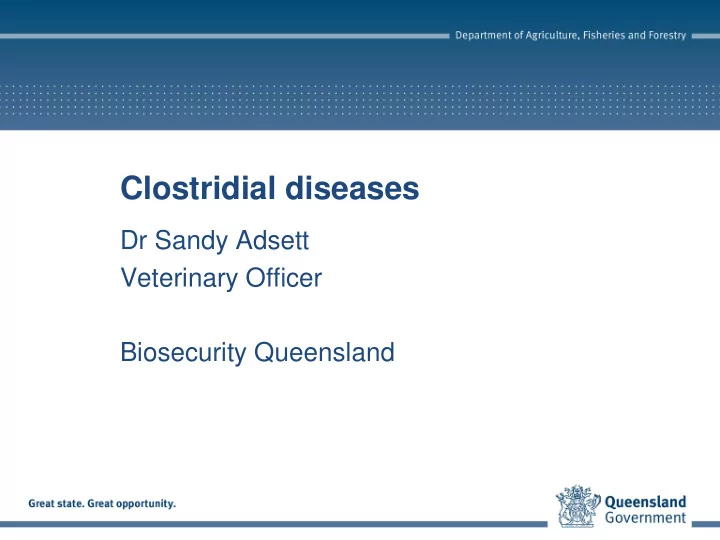

Clostridial diseases Dr Sandy Adsett Veterinary Officer Biosecurity Queensland
Clostridial diseases Tetanus ( Clostridium tetani) Blackleg ( Clostridium chauvoie) Cl. tetani Black disease ( Clostridium novyi) Malignant oedema ( Clostridium septicum ) Pulpy kidney ( Clostridium perfringens) Botulism ( Clostridium botulinum ) Cl. perfringens Cl. botulinum
Tetanus ( Cl. tetani) Soil and intestinal tract Enters through wounds Incubation period 10 – 14 days Production of toxin – affects the nervous system
Horses and lambs most sensitive Limbs rigid, head bent back Typical ‘saw - horse’ stance Contraction of facial muscles – ‘grin’
Protruding 3 rd eyelid
Prevention: Vaccination Clean procedures/instruments Anti-toxin
Blackleg (Cl. chauvoei) Acute, highly fatal disease Affects cattle and sheep Spores in soil and intestinal tract
Sheep: Result of a wound infection, injury Cattle: No history of wounds, Bruising or excessive exercise Beef breeds in excellent health, gaining weight 6 – 24 months old
+/- signs – often cattle found dead. Acute, severe lameness and marked depression. Fluid filled tissue (oedematous) with crackling (crepitant) swellings in the hip, shoulder, chest, back, neck, or elsewhere
Prevention/control: Vaccinate Sheep class Vaccination time Clostridial diseases and cheesy gland *Ideally this vaccination also Ewes Annually, 2 to 6 weeks pre-lambing. needs to be within 6 months of shearing, but not at shearing, Young sheep should be vaccinated Wethers especially if cheesy gland is known before going to pasture. Immunity to be a problem. in young sheep is relatively short – boosters every 3-4 months (esp if going onto lush pastures) Lambs First dose at marking, second dose 4 to 6 weeks later or at weaning. Introduced sheep If the sheep have not previously been vaccinated or if the vaccination status is unknown, treat them with 2 doses of vaccine, 4 to 6 weeks apart. If the previous vaccination program is known then it should be continued, adapting the timing to fit in with flock management. Prevent overcrowding at feeders Minimise rough handling to decrease bruising Clean equipment
Blacks disease ( Cl. novyi) Acute, highly fatal disease
Pasture contamination by faeces - most important source of infection Multiplication of organism in liver following liver fluke migration
Rarely see clinical signs Cattle are often found dead Most prevalent in well-nourished adult sheep infected with liver flukes Liver fluke in bile ducts
Prevention/control Fluke control plan Vaccination programme Proper disposal of carcasses (burning).
Malignant oedema ( Cl. septicum) Acute, generally fatal All species and ages affected Found in soil and intestinal tract Swollen lymph node
Infection via Wound contamination Activation of dormant spores Risk factors Traumatic lambing/calving, docking, castration
Toxins secreted by bacteria causes cell death and disrupts cell function Causes excess inflammation – leads to oedema and tissue death (gangrene) Bacteria in fluid filled tissue
Clinical signs: Soft swellings - pit on pressure Muscles dark brown to black Accumulations of gas in tissue Extremely painful Rams: Infections from fighting.
Prevention/control Vaccination Endemic areas: before surgical procedures. Two doses 2 – 3 weeks apart Annual vaccination in high-risk areas Revaccinate after severe trauma. Separation of rams where possible
Pulpy kidney ( Cl. perfringens) Affects sheep goats and cattle Most common in rapidly growing lambs
Multiplication of normal intestinal - sudden change to a low-fibre, high-carbohydrate diet Toxin produced
Prevention/control Routine vaccination Outbreak: vaccinate immediately - booster if previously vaccinated Change diet – poorer feed/hay * No change in diet, no vaccination: Mortality rates may be as high as 10% - usually the best sheep die.
SUMMARY Clostridial organisms: Normal intestinal and soil flora Become problematic with dietary stress, injury, changes in management, parasitism or other unusual circumstances that set up a favourable growth environment Result in production of potent toxins.
SUMMARY (CON’T) Carry a very poor prognosis First sign of illness may be death. Treatment success is rare, emphasis is properly placed on preventive measures. Vaccines can be an efficient way to reduce losses A single vaccination does not provide adequate levels of protection therefore 2 doses 4 to 6 weeks apart then annual booster dose
THE END
Recommend
More recommend